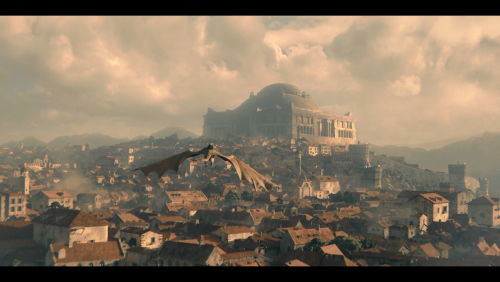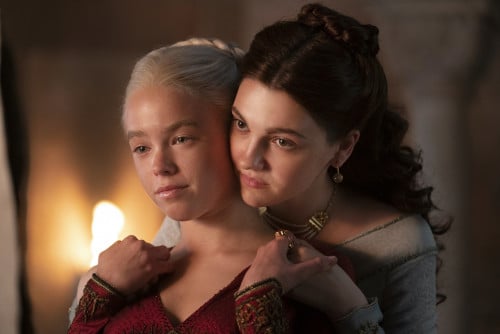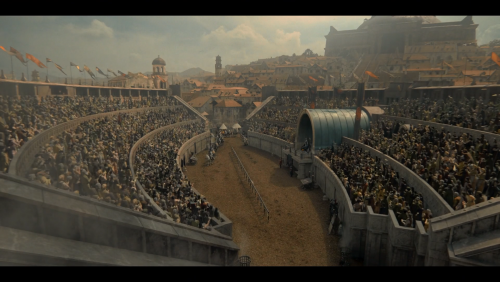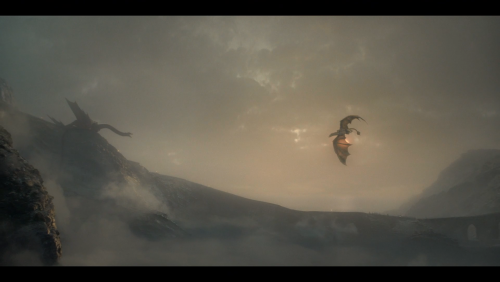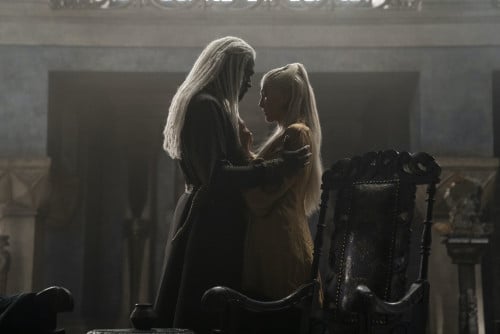Westeros
The 'A Song of Ice and Fire' Domain
Features
We’ve had the opportunity to watch the first six episodes of House of the Dragon, and we certainly have some thoughts about the show. Maybe too many thoughts.
Why This Isn’t a Review
First, a disclaimer: Linda and I have discussed a fair bit about how exactly to write about the show. The fact is that we have a connection to the Dance of the Dragon material that is unique. George first wrote the material, almost precisely as it is presented in Fire and Blood, for The World of Ice and Fire. A book we co-authored with him. And when it proved, as with most of the Targaryen material, well beyond the size we could publish in that book, we used it to summarize very, very concisely the events of the Dance, giving readers some of their first looks into that period. And now we’ve done it again, at George’s and Random House’s kind request, in the forthcoming The Rise of the Dragon (out on October 25th!)
We did not write the material ourselves, but we’re very aware it was first written for the book with our names on it, and we did use it in getting that book to publication. So it feels strange to think about trying to review the show as we did Game of Thrones, a show based on books where George is the sole and only author, a show based on books we are not creatively involved in except in the most nebulous, “Yeah, sometimes we answer questions for George” kind of way. It feels almost like… I don’t know, reviewing our own book, even though we’ve no financial stake in House of the Dragon, no contracts with HBO, no real stake at all really; we’ve not been asked questions about the setting as we sometimes (unofficially) were asked by the writers of Game of Thrones, more a testament to Ryan Condal’s deep love of the world long before the TV show came around than anything else.
Perhaps that cognitive dissonance is more my part than Linda’s, though. She has a point when she notes it’ll be practically impossible to not convey a sense of whether we like or dislike something, however circumspect we are, if we insist on discussing it. And yet… here we are discussing it, trying to walk that self-imposed tight-rope, because it’s a part of the world of Ice and Fire, and how can we not? But in general we’re going to attempt to discuss the show, both in this essay and in any other content we do, with an eye to mostly just providing information about background details that get referenced along the way, or discussing how and maybe why something has “changed” from the account given in Fire and Blood.
Lets get to it.
On Adaptation
Because F&B is presented as the work of Gyldayn writing about events more than a century before him, and using multiple sources who are sometimes contradictory, the show has a very free hand to navigate a path through the materials (and sometimes even contrary to all the accounts we have) to form a single, unified, “objective” narrative. One aspect we did not consider, really, was the possibility that sometimes the writers could decide that the three dueling sources are all wrong, and the truth in the GoT-version of events is very different. Right now, this seems to affect the depiction of one of the primary characters more than anyone else, in a way that may please some and anger others. For our part, we think there’s maybe a risk that this particular character will come off in a too-positive light compared to Fire and Blood’s duelling accounts, and consequently place her opposite number in too-negative a light for some in the audience. We’ll have to say how that plays out.
Speaking of an objective account of the Dance of the Dragons, however, one thing we do need to note is that some in the press and even the fandom believe that remarks from Ryan Condal suggest that the account presented here is the “objective” version of Fire and Blood, the “real” history. What some have taken out of these remarks is that this is the real history that George obscured in F&B… and it is, but only to a point: it is the objective account of the Dance within the Game of Thrones TV universe, but it is not the “actual” version of events within the A Song of Ice and Fire universe. How do we know this? Well, for one thing, one of the major changes to the story has been making Rhaenyra and Alicent much closer in age, and essentially childhood friends. More importantly though, George has spoken in interviews of the fact that even here he doesn’t necessarily have 100% say on the way the story goes – Condal is the head writer, and runs the show with Miguel Sapochnik – and so it’s not the case that everything we see on screen is going to be from his mind, but he accepts it if his collaborators are really convinced that they have only one way to go.
So, again, it’s the objective, actual GoT version of events, but it simply isn’t the objective version of the ASoIaF events. It may be that the way some of the events of the show play out are more-or-less what George has in mind for the real Dance… but the thing as a whole? No.
Decadence
As I said when I walked out of the premiere screening in Amsterdam, the show really does bring to life Westeros in a way that we haven’t seen before. Linda concurs. This is not just because of the budget being approximately 5 times greater than what Game of Thrones had in its first season, although that’s certainly a part of it. The trailers reveal there’s a tournament in the show, and indeed there is, far grander than any tournament seen on, we think, any other TV show to date. Knights wear their own heraldry, proudly, rather than wearing the arms of their overlords, and the heraldry is vibrant in its colors. Rooms are opulently appointed, filled to the brim with examples of conspicuous consumption. The clothing of everyone, down through to the Red Keep’s servants, have a greater richness and variety in colors and cuts, and you can see how Jany Temime and her team have tried to work backwards from Game of Thrones, showing fashions nearly two centuries before the time of Game of Thrones (a hint: there’s more caps in the first episode than we think were depicted in the entirety of GoT).
Though, on the subject of opulence: the private chambers and the not-so-private halls of the Red Keep in this generation are absolutely covered in pornographic artwork. We know, of course, that the show runners have spoken of depicting this era as being one of great decadence, but it does naturally lead to questions like… who exactly decided to put all the pornography on the walls? Hard to imagine the Old King festooned the walls like that, and Maegor the Cruel would surely have preferred scenes of battles and hunts.
The decadence of the show’s take on this era runs further than just naughty artwork, though. Some of the violence – particularly in the first and fifth episodes – is legitimately stomach-churning… and call into question just how willing the people of Westeros are to entertain fairly explicit murderous acts in public. Again, this is an era being presented as one of great decadence, a sense of an almost-perpetual bacchanal at court and the most violent of “bread and circuses” for the smallfolk, but it takes it to an extreme (especially later in the season) that we think may unsettle some viewers… and make others question whether it actually quite makes sense in all instances.
Dragons and Characters
We can’t talk of the Dance of Dragons without talking, of course, of dragons. We see a number of them in those first six episodes, and they are spectacular. As George hoped, the colors on these dragons are more distinct than on Game of Thrones, and there’s certainly a greater variety in their designs. Caraxes is, in particular, remarkably cool (and closer, we expect, to what George describes in the novels). The flying sequences are exhilarating, as you’d expect. And yes, fans will have noticed the saddles the dragons wear. Related to them are the Dragonkeepers, who are … a little bit different than they are described in Fire and Blood, more an ascetic order of dragon-worshippers than a military order of guards. Some of them are so devoted that they appear to speak only High Valyrian.
The cast of the show is quite strong, we think, especially Paddy Considine as King Viserys – he brings a great deal of pathos to the character, partially through a reveal that we suspect is not quite what was intended by George in Fire and Blood but is based on things that other Targaryens were concerned about and simply extrapolated to Viserys. On Matt Smith, Linda and I are somewhat divided, as I think him wonderfully good at playing sly and petulantly arrogant, whereas Linda feels that Smith’s Daemon comes off as too petulant rather than just right, but she notes that after the first two episodes he works rather better for her. The young actresses playing Rhaenyra and Alicent do a good job, and those playing the older versions of the characters match them. In particular, the sixth episode opens with a long pair of scenes focused on Emma d’Arcy’s Rhaenyra, and they are magnetic.
Hollywood’s Social Conscience
The broad outline of the events are all there, even if sometimes with some surprising changes (like the manner of a particular death in the 5th episode). We aren’t sure we’d have made the same choices in all cases – in fact, we’re sure we wouldn’t – but outside of one or two head-scratchers almost everything they’ve done seems very defensible. Not all the changes can be explained as purely a matter of getting the material translated to the screen, of course, and one in particular regarding a male character feels so oddly unnecessary that we wonder if there were external reasons for the change (i.e. the writers did it for fear of criticism, because of something similar Game of Thrones did with one of its secondary characters).
Which leads to a touchier subject. Much angst has been spent on the casting of House Velaryon on the show. Some of it (too much of it) comes from, very clearly, racists – we’ve blocked more than a few who tried to include us in their racist rants about the matter, and will continue to do so because we have no time for that corrosive nonsense. And yet some of it comes, quite fairly, from fans who love George’s worldbuilding and don’t want it compromised unnecessarily. That would be us, for one. Unfortunately, in the zeal of fandom, the very nasty habit of social media to cry “Racist!” even at people who have been extremely consistent at decrying basically all changes to worldbuilding (#FixTheSeahorse) has been decidedly annoying. Some of you need to stop being so online, go outside, touch grass, and get a sense of proportion.
The funny thing is, when the casting of Corlys Velaryon (by actor Steve Toussaint) was announced, a strange thing happened: fans started trying to convince themselves, and others, that in fact the Velaryons were black in the books, or at least they could be. I hesitate to use the term, but it felt a lot like gaslighting. Of course, these attempts were misguided and wrong. George was nearly as explicit as he could be, in the novels, in The World of Ice and Fire, and even in Fire and Blood. Any attempt to point that out? “Racist!” It was absurd.
Of course, in recent interviews the show runners have acknowledged the change of the race of the Velaryons, that it is different from the canon, and they provided their reasons, indicating that it was for well-intentioned reasons of diversity of the cast. This shouldn’t really be a surprise, given so much of the discourse around Hollywood these days. If you kept a tab on the various successor pitches, every single one of them that we have alleged details of had references to finding ways to have a more diverse cast of actors, suggesting that HBO itself was making this a factor in deciding what pitches to develop. We admire the fact that Condal and Sapochnik didn’t beat around the bush about it, though, and didn’t join in attempts to try and gaslight fans by pretending that everyone simply misunderstood ASoIaF. We wish more fans followed their lead.
As it happens, one of the interesting surprises of watching these episodes is that it becomes quite clear that the change has led to the writers adjusting other details of the history of the Targaryens to minimize the knock-on effect of their closest Valyrian neighbors and allies having a markedly different skin color. So the writers not only acknowledge it’s a change, but have gone ahead and changed even more of the GoT-universe history concerning the Targaryens and Velaryons so that their distinctly different looks (unified only by the silver hair) makes more sense. Good on them, paying attention to their worldbuilding and thinking it’s important to have internal justification for these things. Admittedly, if we had had the choice, we’d have suggested making Criston Cole black, and later certain of the Dragonseeds. Or if we needed more characters, well, why not the Hightowers? Changing the history of that ancient and rather unique family (who never appeared in Game of Thrones, after all) and perhaps even of their vassals in the southwest of the Reach, would give us a number of lead characters who are black or mixed-race and open the possibility to depict Oldtown as way more cosmopolitan, and far more diverse, than King’s Landing or, indeed, any other place in Westeros (except perhaps the islands of the narrow sea)..
Why change the Hightowers instead of the Velaryons,? Given the stated reality of the situation – that the writers wanted to find roles for actors of color– it seems to us that at least that would be a better compromise because the drive for blood-purity among the Valyrians, driven by matters of magic and the deep, deep lore of the dragons that Martin has come up with, is better served if the Velaryons and the Targaryens are practically cousin families, deeply intertwined with one another, we think. But, they went the way they did, and so it goes. Steve Toussaint, who I interviewed briefly in Amsterdam does a fine job as Corlys, conveying a man of deep, even overwhelming ambition who rarely takes “No” for an answer, who has achieved all the great things he has achieved in his storied life because he always wants more. He’s also possibly the tallest member of the main cast, which you can’t help but notice – it adds a physical weight and presence to Corlys on the screen which I think works very well.
Conclusion
In the end, the show seems to be in excellent hands. The writers clearly love the setting, filling nooks and crannies of the dialog with passing references to historical matter or certain turns of phrase pulled straight from the novels, often with no further explanation but simply helping give the sense of a world that existed before the TV show opened a window into it and will continue to exist once the show is done. Sapochnik’s direction in the first and sixth episodes is unimpeachable – the opening of episode 6 is particularly strong, in our mind, thanks to that direction – and helps set an overall style reminiscent of the cinematography of Game of Thrones but with quite a bit more saturation and vibrancy. George and HBO have found the right team, we suspect, to bring the Dance to the mass audience. Of course, we thought the same of Game of Thrones after the first season, which had its head-scratchers too but was otherwise quite faithful, so take our view with a grain of salt. Still, right now we see no reason to worry for the show thanks to the way George is deeply involved in a way that he wasn’t since the very earliest days of Game of thrones, and the fact that Ryan Condal has been a fan of the novels for longer than some Game of Thrones fans have been alive.
We suspect the show will be a hit, and it will be deservedly so. But we urge anyone reading this who has doubts because of season 8’s controversial ending to give it a try, focusing on the fact that it is a completely different creative team. It’s not reasonable, in our opinion, to blame one group of artists for something some other group of artists did. Enter the first episode with an open mind, and we suspect you’ll want to keep watching once it’s done.
Tags: Thoughts, Not-a-Review, House of the Dragon, Essay, Adaptation Articles | PermaLink
